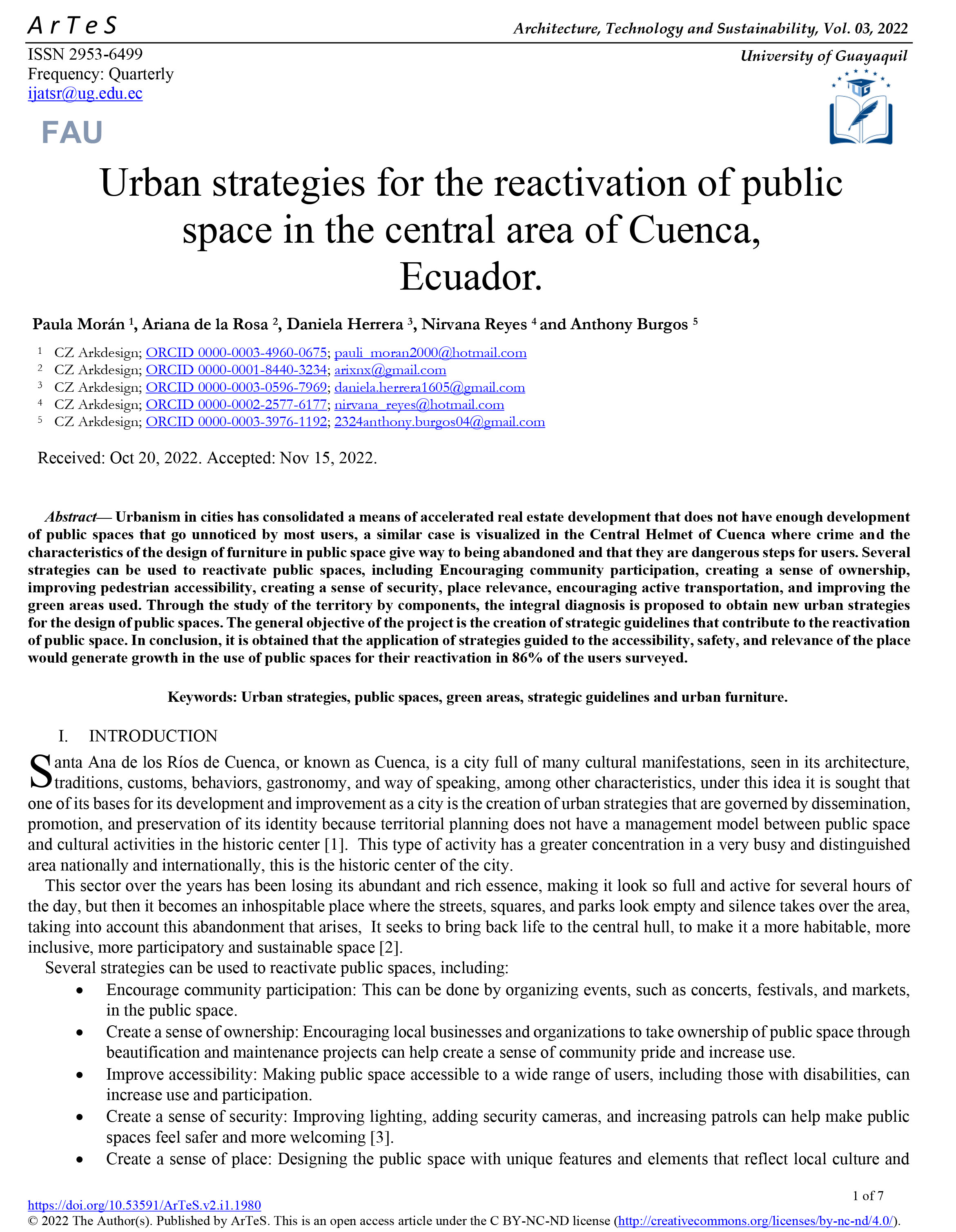Urban strategies for the reactivation of public space in the central area of Cuenca, Ecuador
DOI:
https://doi.org/10.53591/ArTeS.v3.i1.1980Keywords:
Urban strategies, Public spaces, Green areas, Strategic guidelines, Urban furnitureAbstract
Urbanism in cities has consolidated a means of accelerated real estate development that does not have enough development of public spaces that go unnoticed by most users, a similar case is visualized in the Central Helmet of Cuenca where crime and the characteristics of the design of furniture in public space give way to being abandoned and that they are dangerous steps for users. Several strategies can be used to reactivate public spaces, including Encouraging community participation, creating a sense of ownership, improving pedestrian accessibility, creating a sense of security, place relevance, encouraging active transportation, and improving the green areas used. Through the study of the territory by components, the integral diagnosis is proposed to obtain new urban strategies for the design of public spaces. The general objective of the project is the creation of strategic guidelines that contribute to the reactivation of public space. In conclusion, it is obtained that the application of strategies guided to the accessibility, safety, and relevance of the place would generate growth in the use of public spaces for their reactivation in 86% of the users surveyed.
References
A. Serra-Llobet y MA Hermida, “Oportunidades para la infraestructura verde bajo el nuevo marco legal de Ecuador”, Landsc. Urban Plan., vol. 159, págs. 1–4, 2017, doi: 10.1016/j.landurbplan.2016.02.004.
KB de Castro et al., “Nuevas perspectivas en el mapeo del uso del suelo basadas en la morfología urbana: un estudio de caso del Distrito Federal, Brasil”, Land use policy, vol. 87, sep. 2019, doi: 10.1016/j.landusepol.2019.104032.
A.-A. Gavrilidis, A.-M. Popa, M.-R. Nita, D.-A. Onose y D.-L. Badiu, “Planificación de lo 'desconocido': Percepción del concepto de infraestructura verde urbana en Rumania”, Urban For. Urban Green., vol. 51, p. 126649, 2020, doi: https://doi.org/10.1016/j.ufug.2020.126649 .
A. Macmillan, J. Connor, K. Witten, R. Kearns, D. Rees y A. Woodward, “Los costos y beneficios sociales del uso de la bicicleta como medio de transporte: simulación de los efectos de políticas específicas mediante el uso de modelos de dinámica de sistemas”, Environ. Health Perspect., vol. 122, núm. 4, págs. 335–344, 2014, doi: 10.1289/ehp.1307250.
AJ Lynch, “Creación de vías verdes urbanas efectivas y trampolines: cuatro brechas críticas en la investigación de planificación de conectividad del hábitat”, Journal of Planning Literature, vol. 34, no. 2. SAGE Publications Inc., págs. 131–155, 1 de mayo de 2019. doi: 10.1177/0885412218798334.
Z. Zhang, S. Meerow, JP Newell y M. Lindquist, “Mejorar la conectividad del paisaje mediante el diseño y modelado de corredores de infraestructura verde multifuncional”, Urban For. Urban Green., vol. 38, págs. 305–317, febrero de 2019, doi: 10.1016/j.ufug.2018.10.014.
R. Velho, C. Holloway, A. Symonds y B. Balmer, “El efecto de la accesibilidad del transporte en la inclusión social de los usuarios de sillas de ruedas: un análisis de métodos mixtos”, Soc. Incl., vol. 4, núm. 3, pág. 24, junio de 2016, doi: 10.17645/si.v4i3.484.
I. Essadeq, E. Dubail y E. Jeanniere, “Modelado de la congestión de pasajeros en el sistema de tránsito: estudio comparativo y tres casos de estudio”, Transp. Res. Procedia, vol. 14, págs. 1792–1801, enero de 2016, doi: 10.1016/J.TRPRO.2016.05.145.
SN de Planificación, Plan de Creación de Oportunidades 2021-2025. Ecuador, 2021, pág. 122. Consultado: 24 de marzo de 2022. [En línea]. Disponible: https://www.planificacion.gob.ec/plan-de-creacion-de-oportunidades-2021-2025/
VR Ibárcena, “Criterios de diseño y transformación de los espacios públicos en los asentamientos humanos de Perú: estudio del espacio público en las ciudades informales”, Valencia, 2018. Consultado: 20 de junio de 2020. [En línea]. Disponible: http://hdl.handle.net/10251/99585
AC Oliveira y C. Alho, “Las nuevas ciudades inteligentes. Ciudades construidas desde cero y ciudades antiguas transformadas en ciudades inteligentes. Crecimiento sostenible”, en Desafíos para la innovación tecnológica: una agenda para el futuro - Actas de la Conferencia internacional sobre fabricación inteligente sostenible, S2M 2016, 2017, págs. 311–314. doi: 10.1201/9781315198101-62.

Downloads
Published
How to Cite
Issue
Section
License
Copyright (c) 2022 a Juan Carlos Reyes Rivera; Paula Morán Icaza, Ariana Paulette De La Rosa Rocafuerte, Marilyn Daniela Herrera Guaranda, Nirvana Rashel Reyes Miranda, Anthony Carlos Burgos Vargas

This work is licensed under a Creative Commons Attribution-NonCommercial-NoDerivatives 4.0 International License.



